When it comes to exotic fruits that tantalize both the eyes and taste buds, few can rival the captivating allure of the rambutan fruit. Hailing from Southeast Asia, this peculiar-looking tropical delicacy has gained popularity worldwide, not only for its unique appearance but also for its delectable flavor and impressive health benefits.
Join me on a delightful journey as we explore the wonders of the rambutan fruit.
Appearance of the Fruit
At first glance, the rambutan may seem like an extraterrestrial creation with its spiky exterior. However, don’t be fooled by its intimidating appearance.
As you peel away the vibrant red or yellow rind, a juicy and translucent flesh reveals itself, reminiscent of a lychee. This fleshy orb cradles a single seed, which is discarded before savoring the succulent treasure within.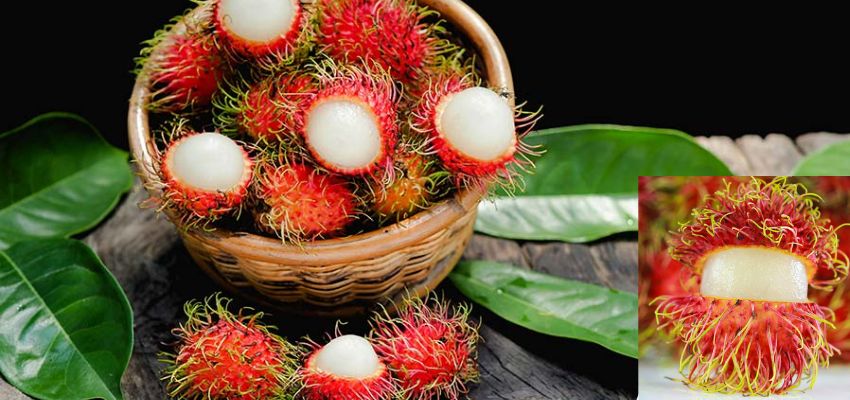
Natural Taste of the Fruit
The taste of rambutan is truly a gift to the senses. With a perfect balance of sweetness and acidity, each bite is a burst of tropical goodness. Its flavor can be compared to a combination of lychee and grape, with subtle floral notes.
The soft, juicy texture complements the flavor, making it a delightful treat on a hot summer day or a refreshing addition to fruit salads and desserts.
Look at the ultimate guide for a timeless beauty
Lychee vs Rambutan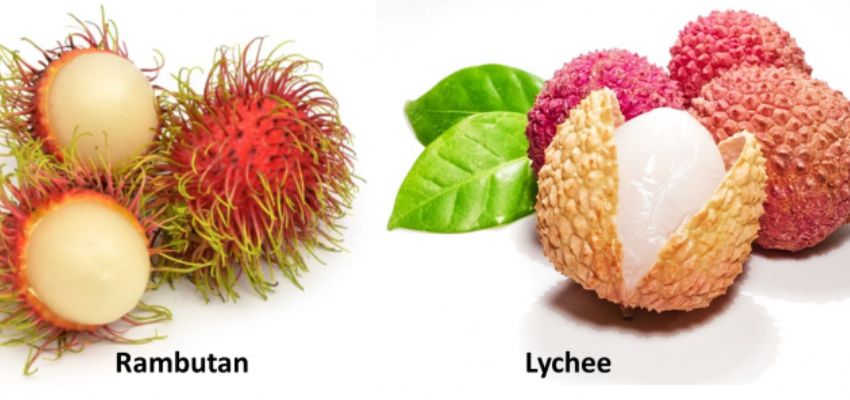
| Lychee | Rambutan |
| Lychee fruit features a rough, bumpy, and reddish-pink shell that is easy to peel away. | Rambutan has a spiky exterior that resembles a hairy shell. The color of the rambutan can vary from red to yellow, depending on the variety. Once peeled, the flesh is also translucent, but it is typically juicier and more gelatinous compared to lychee |
| Lychee has a sweet, fragrant flavor with subtle floral undertones. The flesh is juicy and succulent, offering a delightful combination of sweetness and slight acidity. Many describe the taste of lychee as similar to a grape, but with a unique tropical essence. | It is also sweet and juicy, but it tends to have a slightly milder and less acidic flavor compared to lychee. Rambutan’s taste is often described as a blend of lychee and grape, with hints of tropical notes. |
| Lychee is widely cultivated in many tropical and subtropical regions, including China, India, Thailand, and Brazil. It is commonly available in both fresh and canned forms in many supermarkets around the world. | Rambutan is primarily grown in Southeast Asia, including countries like Thailand, Indonesia, and Malaysia. It is less widely available compared to lychee, but it can be found in specialty markets and some supermarkets in regions where it is imported. |
Health Benefits of Rambutan
Rambutan is not only a delicious tropical fruit but also offers several health benefits due to its impressive nutrient profile.
Here are some of the potential health benefits associated with consuming rambutan:
Immune System Boost
Rambutan is a rich source of vitamin C, which is essential for a healthy immune system. Vitamin C acts as an antioxidant, protecting cells from damage, and helps strengthen the body’s defense against infections and illnesses.
Antioxidant Power
Rambutan contains antioxidants like flavonoids and phenolic compounds. These antioxidants help neutralize harmful free radicals in the body, reducing oxidative stress and lowering the risk of chronic diseases, such as heart disease and certain types of cancers.
Digestive Health
Rambutan is a good source of dietary fiber, which aids in digestion and helps maintain a healthy digestive system. Adequate fiber intake promotes regular bowel movements, prevents constipation, and supports a healthy gut microbiome.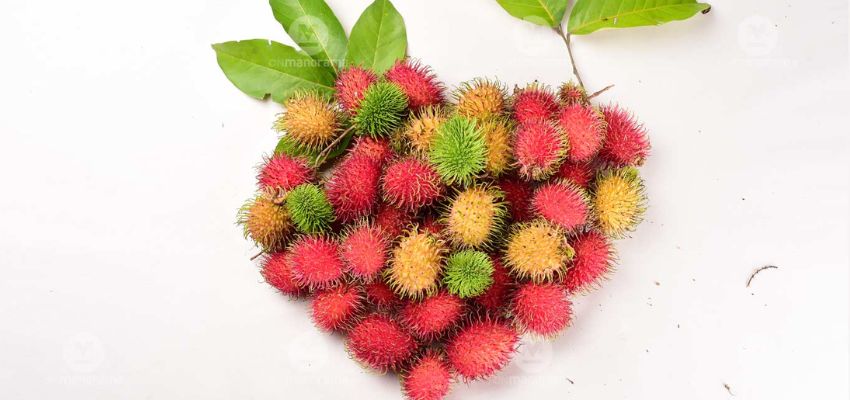
Healthy Skin
Rambutan’s high vitamin C content plays a crucial role in collagen synthesis, a protein that supports skin structure and elasticity. Consuming rambutan can help improve skin health, promote a youthful appearance, and aid in wound healing.
Energy Boost
Rambutan contains natural sugars, including fructose and sucrose, which provide a quick energy boost. It can be a great snack option for those needing an instant pick-me-up.
Hydration
Rambutan has a high water content, making it a hydrating fruit that can contribute to maintaining optimal hydration levels in the body.
Nutrient Density
Rambutan is a good source of various vitamins and minerals, including manganese, copper, iron, and potassium. These minerals play essential roles in various bodily functions, such as maintaining healthy blood cells, supporting nerve function, and regulating blood pressure.
Consider reading skin benefits of using rose water
Rambutan Healthy Recipes for Skin and Health
Rambutan Smoothie Bowl
Ingredients
- 1 cup frozen rambutan (peeled and deseeded)
- 1 frozen banana
- 1/2 cup spinach or kale
- 1/2 cup unsweetened almond milk (or any preferred plant-based milk)
- Toppings: sliced rambutan, chia seeds, shredded coconut, granola, or sliced almonds
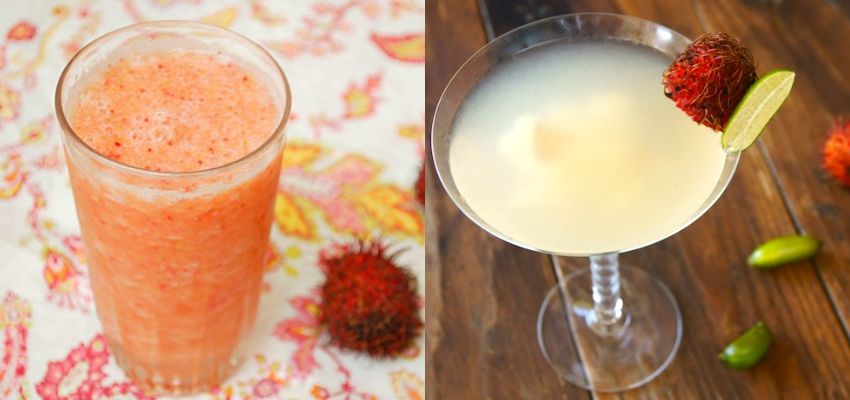
How To Prepare
- In a blender, combine the frozen rambutan, frozen banana, spinach or kale, and almond milk.
- Blend until smooth and creamy. If the consistency is too thick, you can add more almond milk as needed.
- Pour the smoothie mixture into a bowl.
- Top with sliced rambutan, chia seeds, shredded coconut, granola, or sliced almonds.
- Enjoy this refreshing and nutrient-packed smoothie bowl that promotes skin health and provides a range of essential vitamins and minerals.
Rambutan Mixed Berry Salad
Ingredients
- 1 cup rambutan (peeled and deseeded)
- 1 cup mixed berries (such as strawberries, blueberries, and raspberries)
- 2 cups mixed greens (spinach, arugula, or lettuce)
- 1/4 cup sliced almonds
- 1/4 cup crumbled feta cheese (optional)
- Dressing: 2 tablespoons olive oil, 1 tablespoon balsamic vinegar, 1 teaspoon honey, salt, and pepper to taste
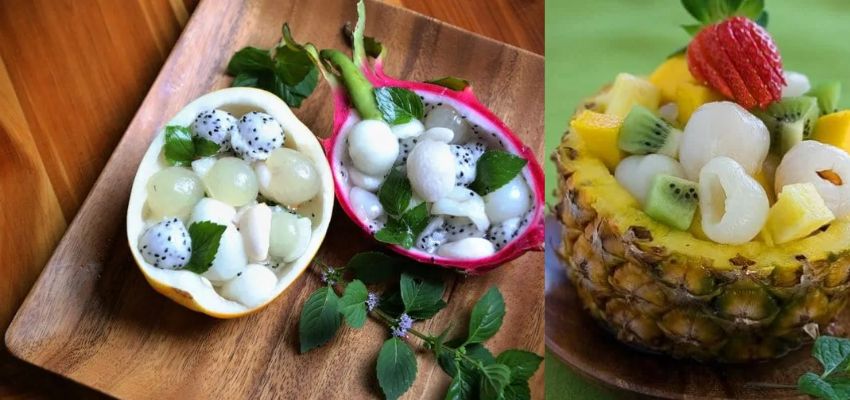
How To Prepare
- In a large bowl, combine the mixed greens, rambutan, mixed berries, sliced almonds, and feta cheese (if desired).
- In a separate small bowl, whisk together the olive oil, balsamic vinegar, honey, salt, and pepper to make the dressing.
- Drizzle the dressing over the salad and gently toss to coat all the ingredients evenly.
- Serve the salad as a refreshing and nutritious side dish or add grilled chicken or tofu for a complete meal. This salad is rich in antioxidants, vitamins, and healthy fats, which promote skin health and overall well-being.
Rambutan Curry
Ingredients
- 2 cups rambutan (peeled and deseeded)
- 1 onion, finely chopped
- 2 cloves of garlic, minced
- 1-inch piece of ginger, grated
- 1 tablespoon curry powder
- 1 teaspoon ground turmeric
- 1 teaspoon ground cumin
- 1 teaspoon ground coriander
- 1 cup coconut milk
- 1 cup vegetable broth
- 1 tablespoon cooking oil (such as coconut oil or vegetable oil)
- Salt and pepper to taste
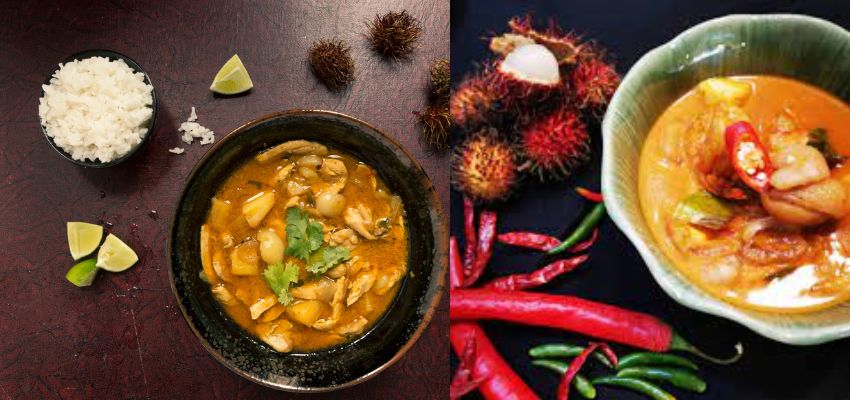
How To Prepare
- Heat the cooking oil in a large pan over medium heat. Add the chopped onion, minced garlic, and grated ginger. Sauté until the onion becomes translucent and aromatic.
- In a small bowl, combine the curry powder, turmeric, cumin, and coriander to make a spice mixture.
- Add the spice mixture to the pan and stir well, allowing the spices to toast for a minute or two.
- Add the rambutan to the pan and gently stir to coat them with the spices.
- Pour in the coconut milk and vegetable broth. Stir to combine all the ingredients.
- Bring the mixture to a simmer and let it cook for about 10-15 minutes, or until the rambutan are tender and the flavors are well combined. Adjust the seasoning with salt and pepper according to taste.
- Once the curry is cooked, remove it from the heat.
- Serve the rambutan curry over steamed rice or with your choice of bread. Garnish with fresh cilantro if desired.
CONCLUSION
The rambutan fruit is truly a gem among nature’s bounties. From its captivating appearance to its delightful taste and remarkable health benefits, it continues to captivate fruit enthusiasts around the world.
Whether enjoyed on its own or incorporated into various culinary creations, rambutan offers a tropical escape with every bite. So, the next time you come across this exotic fruit, be sure to indulge in its juicy splendor and savor the enchanting flavors of the rambutan.
Look at the top benefits of chia seeds